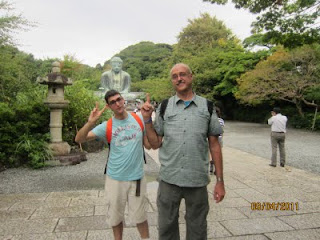
Charlie Engler, Shirley and Andy. My companions traveling to Kamakura and Yokohama on Monday. Our choice for a day trip after the typhoon cancelled Charlie, Shirley and me from the adventure. Actually all three of these folks have already scaled the mountain. Maybe next time for this guy. :-)
ref="https://blogger.googleusercontent.com/img/b/R29vZ2xl/AVvXsEi4Z5Z7wxoTnBfVrR3Ax3T1r3lNTuvNNq5OzQlB5mEP0832HFUPJicwMgNWga3KX0ugfVRJrEN7QUxXQmsZHr8b-Kp2AsH0WVnhvTDwWFu6PFdCylwukUHAXJOrdCwIQ2OIzukflI7IH93T/s1600/IMG_1107.JPG">

Signage for me to go straight. Not a possibility for some of us, and a useful sign to find the Kamakura Diabutsu (Great Buddha) , which was our first goal before resting and eating nice big sweet grapes that Shirley chose for a snack at the temple.
Here is a sign that includes the "JR"line. This is Japan Rail, the one that has the rail pass. I got all the JR line trains for free with my pass. THere are a lot of private rail lines around Tokyo that require other ways of payment. Locals have a rechargable card like an "Oyster Card" I have seen in the states. That is what Charlie and his friends use. For me, using the coin ticket machines is the daily ritual here for non JR lines. So I keep coins 500 Y and 100 Y available. It is a cash culture so I use the ATM's like in Europe to have enough cash for each day. Also note the simple peace sign or swastica that indicates a temple. THis sign was just near the train station to direct our hike to the sites in Kamakura for the day.

Map of the Kamakura area.

We took the Hase line to near the Hase- Dera Temple and Garden that Charlie had visited before with Aka Ono's Family. Great to have Charlie as the train maven here.

Andy and me entering the Diabutsu (Great Buddha) site.

Classical view of the large metal statue of the Buddha.

When the four of us entered the Hase- Dera Temple and Garden, I noticed the lotus flowers in the pond. I quiet and reflective area. We spent a couple of hours walking around this temple.

Garden pool in the shape of a swastika. Interesting history of the symbol in the East, per Wiki "In Chinese and Japanese the swastika is also a homonym of the number 10,000, and is commonly used to represent the whole of Creation, e.g. 'the myriad things' in the Dao De Jing. During the Chinese Tang Dynasty, Empress Wu Zetian (684-704) decreed that the swastika would also be used as an alternative symbol of the Sun. In Japan, the swastika is called manji. Since the Middle Ages, it has been used as a coat of arms by various Japanese families such as Tsugaru clan, Hachisuka clan or around 60 clans that belong to Tokugawa clan.[25] On Japanese maps, a swastika (left-facing and horizontal) is used to mark the location of a Buddhist temple. The right-facing manji is often referred to as the gyaku manji (逆卍, lit. "reverse manji") or migi manji (右卍, lit. "right manji") , and can also be called kagi jūji (literally "hook cross")."

Main temple building at Hase-Dera.
Here is some insight from my experience, for those who are considering a trip to Japan.
Folks had suggested a day trip to Kamakura, even my Carleton Classmate Paul Smith who doubted that I could have a cost effective journey and include Kyoto in my 9 day trip here in Nippon. The 7 Day Japan Rail pass, paid for itself with the quick ride on the train from Narita to Tokyo Station and then the Bullet Train....Shinkansen...in local parlance. Just like theTGV in France, the Japanese evidently in the 1970's invested in rail..While the US, still stayed addicted to the automobile. It is very easy to get around here, if you are open to riding the trains, without ever getting in a car. So far I have not taken even a taxi. The test will be tomorrow morning, when I get on a subway at 6 AM to get to Tokyo Station to get on the Orange Airport Limosine for the Hour and 20 min ride to Narita, to be there over 2 hours ahead of my flight to Hong Kong.

No comments:
Post a Comment